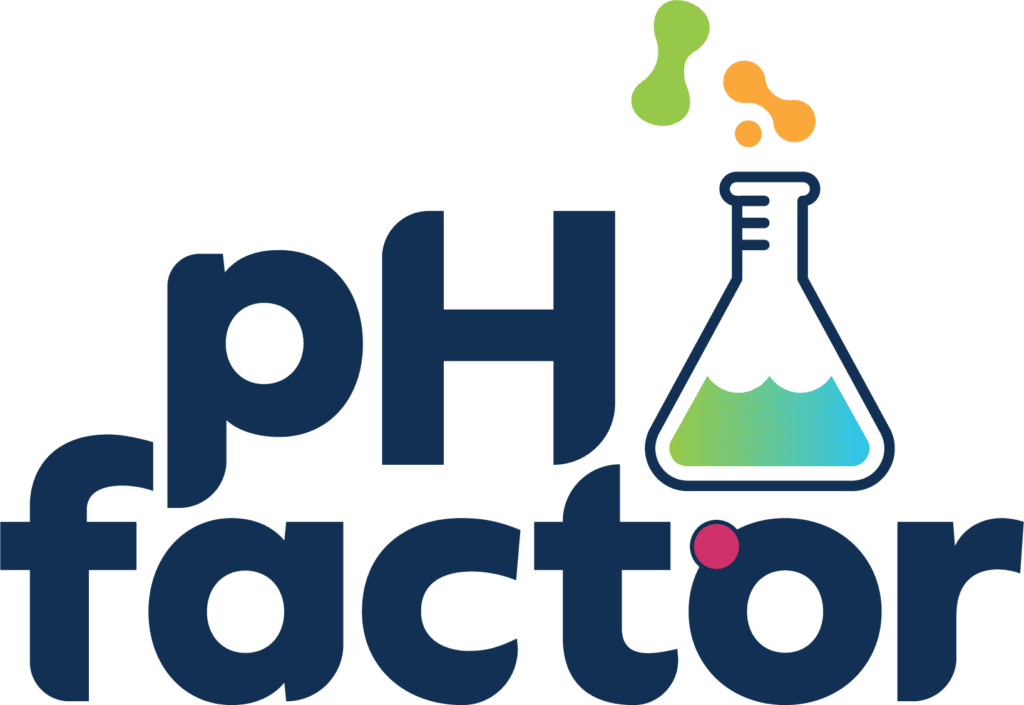From supermarket shelves to social media ads, claims like “Kills 99.99% of germs” and “Antibacterial surface cleaner” dominate the homecare space.
Let us unpack the regulations governing germ-killing claims in the Australian homecare market, how they compare globally, and what formulators and marketers must consider to stay compliant.
Understanding the Claims: What Do They Really Mean?
These claims are based on log reduction testing, a logarithmic scale used to quantify the reduction of microorganisms during disinfectant efficacy tests. In household products, these claims relate to the antimicrobial efficacy, with each representing different levels of germ-killing power.
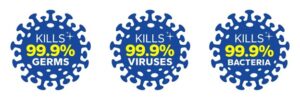
“Kills 99% of germs”
This implies the product contains active ingredients capable of eliminating a broad range of bacteria and/or viruses. This claim indicates a 2-log reduction in microbial population. In logarithmic terms, this means the product reduces the number of viable microorganisms by 99%, leaving 1% of the original population alive. For example, if you started with 1,000,000 bacteria, after treatment you’d have 10,000 remaining.
“Kills 99.99% of germs”
A more assertive version of the above, suggesting laboratory-proven efficacy (usually via TGA-approved test methods) across numerous microorganisms. This represents a 4-log reduction, meaning the product eliminates 99.99% of microorganisms, leaving only 0.01% alive. Using the same example of 1,000,000 bacteria, only 100 would survive treatment. This is significantly more effective than the 99% claim.
“Antibacterial”
Indicates the product prevents or reduces bacterial growth, either on surfaces or as a residual effect after application. This is a broader, less specific claim indicating the product has some level of antibacterial activity. Unlike the percentage claims above, “antibacterial” doesn’t specify the degree of kill rate. Products with this label must demonstrate some antibacterial efficacy, but this could range anywhere from minimal reduction to high-level kill rates. The actual log reduction varies widely depending on the specific product and testing conditions.
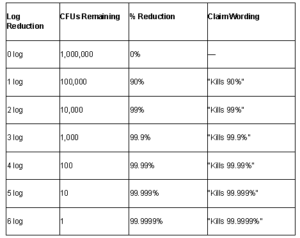
How Is This Tested?
Accredited microbiology labs perform log reduction tests using:
- CFU (Colony Forming Units): A count of visible colonies pre- and post-treatment.
- Control vs. Treated: A baseline colony count compared to the treated surface.
- Time-bound exposure: E.g. 5–10 mins for surface disinfectants.
The Australian Regulatory Framework
Australia splits oversight between AICIS and the TGA, with a third player, ACCC, governing misleading or deceptive advertising.
AICIS (Australian Industrial Chemicals Introduction Scheme)
- Governs general consumer and industrial chemicals
- Allows cleaning claims like “removes dirt”, “cleans effectively”, or even “reduces odours”
- Does NOT permit claims that imply therapeutic benefit, such as “kills COVID-19”, “disinfects”, or “antibacterial” unless TGA compliance is met
TGA (Therapeutic Goods Administration)
- Regulates disinfectants, sanitisers, and therapeutic cleaners
- Products making specific disease, antimicrobial or germ-killing claims must be registered or listed
- Must comply with rigorous testing (AS/NZS 3666.1:2011, AOAC Use Dilution tests, etc.)
- Requires submission of efficacy data, ingredient breakdown, manufacturing validation, and advertising pre-approval
ACCC (Australian Competition and Consumer Commission)
- Oversees truth in advertising
- Can prosecute for false, misleading, or unverifiable claims
- Enforces penalties for “greenwashing” or overstated hygiene promises
What Does the TGA Require in Australia?
If a cleaning product makes therapeutic or disinfectant claims (e.g. kills specific pathogens or “99.99% of germs”), it may be classified under the Therapeutic Goods Act and must:
- Be Listed or Registered in the ARTG
- Provide laboratory evidence supporting efficacy (validated log reduction data)
- Comply with Therapeutic Goods Order No. 104 (TGO 104)
- List active ingredients, batch numbers, expiry, and more on the label
🌐 Learn more – TGA Disinfectant Regulation Guide
Common Claim Pitfalls
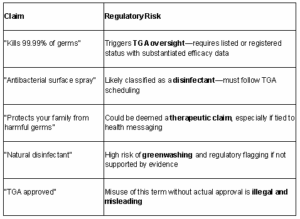
Misleading Claims & ACL Enforcement
Under the Australian Consumer Law (ACL), brands that make unsubstantiated or misleading germ-kill claims may face ACCC penalties. Even saying “antibacterial” must be backed by robust, peer-reviewed test data.
In 2021, the ACCC fined multiple companies for failing to substantiate disinfectant claims made during the COVID-19 pandemic.
Even without therapeutic claims, any product implying health protection should be carefully assessed against the TGA Advertising Code.
Snapshot: Claim Compliance – AICIS & ACCC (ACL)
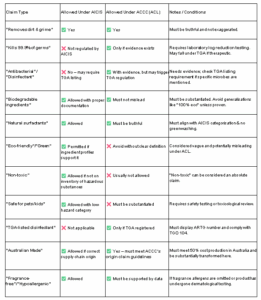
Tips for Brands, Marketers & Formulators
Staying Compliant While Standing Out
FOR BRANDS
1. Be Specific, Not Vague
Avoid terms like “eco,” “non-toxic,” or “safe” without clear definitions or supporting data.
2. Understand Your Product’s Category
Check if your product is a general cleaner (AICIS) or a disinfectant with therapeutic claims (TGA).
3. Keep Records & Evidence
Hold test reports, SDS sheets, and certificates of analysis to defend your claims if audited.
4. Use the ARL (Australasian Recycling Label)
This not only helps consumers but demonstrates responsibility toward end-of-life packaging.
5. Educate Your Retailers
Ensure stockists represent your product and claims accurately on shelves and online.
FOR FORMULATORS
1. Align Claims with Ingredients
Select surfactants, solvents, preservatives, and boosters that support the desired claims (e.g., “antibacterial” or “biodegradable”).
2. Use AICIS Categorisation Correctly
Choose ingredients that are on the AICIS inventory or qualify under Exempted or Reported introductions.
3. Understand Log Reduction Testing
Work with labs familiar with EN standards or AOAC methods to validate kill claims (e.g., 99.99% = 4-log reduction).
4. Consider Skin Contact & Safety
If marketing “gentle” or “dermatologist tested,” ensure toxicological profiles support low irritancy.
5. Stay Ahead of Ingredient Bans
Keep up to date with global chemical phase-outs (e.g., triclosan, quats) to future-proof formulations.
FOR MARKETERS
1. Substantiate Every Claim
Don’t use “buzzwords” unless you can explain and back them up. The ACCC demands transparency.
2. Don’t Confuse ‘Green’ With ‘Clean’
Natural doesn’t always mean safe or effective—consumers value both efficacy and ethics.
3. Avoid Overclaiming with Numbers
If saying “Kills 99.999%,” make sure you have 5-log kill data from an accredited lab.
4. Understand the Power of Front-of-Pack
Your main real estate should balance compliance with appeal—net contents, key claims, and usage all need to be there.
5. Watch Competitor Precedents
Legal action over unsubstantiated claims is increasing. Learn from industry lawsuits and avoid risky wording.
If you’re unsure, contact the team at pH Factor and book some time to chat to the Expert, Rita Sellars
